Images
Courtesy of Terry MichaelsSelect an image to view a larger version
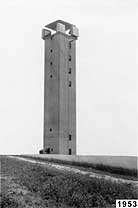
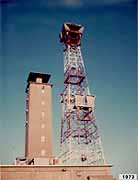

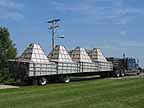
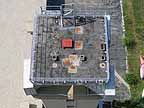


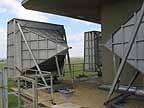
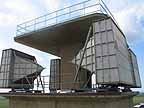
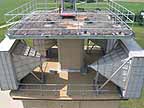
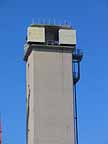
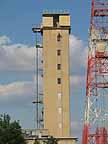
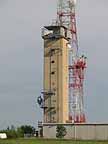
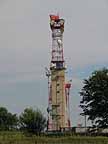

CLLI: LEEILQR
Cancelled call sign: KSA49
Address: 14792 Tower Road, Lee, IL 60530
The Lee, IL site started out as a repeater on the first AT&T transcontinental microwave route, and eventually grew to become a major microwave and coaxial cable junction site.
Land for the site was purchased in April 1949, a type 3B concrete tower was built there in early 1950 using the slip form method, two delay lens antennas were installed on the lower roof platform along with TD-2 microwave radio bays in the building to provide one way television service to Omaha, picking up the signal from Plato Center (Chicago R2W) to the east, and sending it on to Sublette (Chicago R4W) to the west. By 1951 two more delay lens antennas were installed along with additional waveguide and TD-2 bays to provide two way service, the transcontinental microwave route officially began service August 17, 1951.
At a 1949 dinner ceremony the Lee site was dedicated to Randolph Eide, then President of Ohio Bell, afterwards the site was referred to on some plot plan drawings as the "Eide Tower near Lee, IL". Eide grew up in nearby Lee, IL.
In 1954 an 8 foot diameter parabolic dish antenna supported by an A frame mount were installed on the upper deck to provide a TV sideleg feed to Rockford through an intermediate repeater at Kings, IL. Eventually 3 TV channels were carried on this route.
In 1957 a 225 foot type A tower were built alongside the concrete tower, plus a small ground level building containing carrier multiplex equipment. The type A tower carried two pairs of horn reflector antennas for a cross route from Norway, IL through Lee, Winnebago, and Capron to Palmyra, WI for the new "Chicago Bypass Route". A bridge was installed between the two towers to carry the waveguide from the type A tower to the TD-2 radio bays that were installed for this route on the radio room level of the concrete tower.
In 1958 a passenger elevator was installed in the concrete tower, this is the only AT&T concrete tower that was fitted with an elevator.
By 1960 all 6 channels were in use westbound from Lee, however a 7th channel was needed to provide an additional TV network feed from Lee to Davenport via Princeton, IA, so a horn reflector antenna aimed at Sublette was installed on the steel tower to handle the 7 westbound channels, afterwards the westbound delay lens antennas was removed.
All microwave radio equipment for the various routes in and out of Lee was located in the concrete tower at this point, along with 12V, 130V and 250V battery supplies, emergency engine, alarms etc. Like other concrete towers that AT&T built the Lee tower started out with 6 floors. In order to plan for the addition of future equipment 3 more floors were added to the concrete tower, making a total of nine floors. A second bridge running between the two towers was installed to carry waveguide for the interstitial radio channels to radio equipment located on the new 4th floor.
In 1962 another horn reflector antenna toward Sublette was installed on the steel tower, along with two more aimed at Plato Center, once these were in place the remaining 3 delay lens antennas were removed. The side route to Kings was turned down around 1965.
In 1967 the ground level building was greatly expanded, including a substantially sized basement. Over a one year period, technicians moved all operating equipment from the concrete tower into the main building without interrupting service, afterwards the windows in the concrete tower were removed and replaced with concrete panels, all power and cabling between the buildings was disconnected, the two bridges between the towers were removed, and the doors were bolted shut. AT&T wanted to have it demolished, but after the financial disaster incurred after the demolishing of a similar tower at Mishawaka, IN, the concrete tower was abandoned instead.
In 1968 an upper deck was added to the type A tower, turning it into a type A-2 tower. Two horn antennas were installed on the upper deck for a new route to Montclair, IN through Newark, IL. In 1971 an 11 GHz hop to DeKalb was installed. In 1973 two horn antennas were installed on the upper deck for a new route to the Hanover earth station. In 1979 a 10 foot shrouded parabolic antenna was installed below the lower deck of the steel tower for a TV feed to station WREX in Rockford. In 1981 four AR6A routes were added to existing TD-2 routes at the Lee site, also two diversity receive conical horn antennas were added to the steel tower, the concrete tower was used to support two more diversity antennas. By using the formerly abandoned concrete tower to support the two diversity antennas, further reinforcement of the steel tower was avoided. The steel tower had already been reinforced at least once previously by adding additional steel angles to the legs and attaching buried concrete blocks to the existing foundation. In 1982 the main building was expanded for a second time, increasing the overall floor space by about 60%, although technicians who worked there have told me that the additional space was unnecessary and never ended up being used.
Lee also had L4 coaxial cables to Chicago 6 and Plano. Lee was a major switching and patching location for network television programs, in its heyday the Lee site was manned 24 hours per day. In addition to TD-2, TD-3, TH-3, AR6A and Lenkurt microwave radio equipment the Lee site had 100A, 400A and 500A protection switching equipment, MMX3 mastergroup multiplex, group and supergroup distribution frames, and L carrier patching equipment. Lee was also a maintenance center for a number of microwave repeater sites in northern Illinois, and had fully equipped TD-2 and AR6A service benches.
In addition to normal operation during outside electrical power failures, the two 225 KW diesel generators in the main building could be started by radio commands from the local power utility to take the entire site off of the local grid during times of high electric consumption and possible blackouts.
In 1986 the route to the Hanover earth station was retired, two years later the horn reflector antennas for that route were removed by helicopter.
By 1993 all service had been turned off at the Lee site, and all equipment inside the main building was removed by Western Electric crews.
I bought the site in 2002, since then I have been performing historically accurate restoration of the concrete tower. The most significant part of this work was the July 2005 installation of 4 delay lens antennas in their original locations on the roof of the concrete tower. We also fabricated and installed a duplicate of the A frame mount that once supported the dish antenna aimed at Kings, IL.
 |
 |
 |
 |
 |
 |
 |
 |
 |
 |
 |
 |
 |
 |
 |
Updated on March 9, 2008 at 01:12 by Albert LaFrance